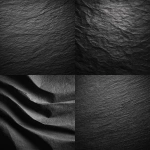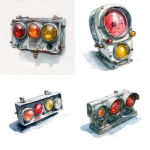Explore the Best AI Image Gallery

Beyond Reality: Wearable Tech and the Evolution of Artistic Expression
The realm of art has always been in a state of flux, constantly evolving with the advent of new technologies. Today, wearable technology stands as a groundbreaking force, poised to reshape the very foundations of creative expression. From immersive virtual reality experiences to interactive augmented reality installations, wearables are blurring the lines between artist and audience, opening up a universe of possibilities for innovation and exploration.
The Wearable Canvas: A New Frontier for Artistic Creation
Wearable technology grants artists a dynamic canvas unlike any they have encountered before. Imagine sculpting with light projected onto the human body, choreographing movements that translate into virtual landscapes, or painting with emotions detected by sensors embedded in clothing. These are just a few examples of how wearables empower artists to push the boundaries of traditional mediums and create truly immersive experiences.
Virtual Reality: Immersing Artists and Audiences
VR headsets have become increasingly accessible, transforming the way we interact with digital environments. For artists, VR offers a platform for creating breathtaking installations that transport viewers to entirely new worlds. Imagine stepping into a virtual gallery where each artwork pulsates with life, responding to your movements and emotions. Or consider a performance piece where dancers move through a surreal landscape, their actions mirrored by shifting light patterns and soundscapes.
Augmented Reality: Enhancing the Real World
AR overlays digital elements onto our physical surroundings, enriching our perception of the world. Artists can use AR to create interactive sculptures that react to viewers, design walking tours that reveal hidden stories embedded within cities, or even transform everyday objects into portals to fantastical realms.
The Ethical Landscape: Navigating Uncharted Territory
As with any powerful technology, wearable tech raises ethical considerations that demand careful attention. Data privacy is paramount, as wearables often collect vast amounts of personal information about users. It is crucial to ensure that this data is handled responsibly and ethically, with transparent consent mechanisms in place.
Another important consideration is the potential for bias and discrimination. Algorithms used in wearable technology can perpetuate existing societal biases if not carefully designed and monitored. It is essential to promote diversity and inclusion throughout the development process to mitigate these risks.
Finally, the line between reality and virtuality can become blurred with immersive technologies like VR. This raises questions about the impact on mental well-being and the potential for addiction. Responsible use guidelines and public discourse are crucial to navigate this complex terrain.
Future Trends: The Ever-Evolving Landscape
The field of wearable tech is constantly evolving, with new innovations emerging at a rapid pace. Some exciting trends to watch include:
- Haptic Feedback: Wearables that can simulate touch sensations will create even more immersive experiences, allowing users to feel objects and interact with virtual environments in a tangible way.
- Brain-Computer Interfaces: Connecting wearable tech directly to the brain could unlock unprecedented levels of creative control, enabling artists to express themselves through thought alone.
- Personalized Experiences: Wearables will increasingly tailor artistic experiences to individual preferences, creating truly bespoke and unique encounters.
The intersection of wearable technology and the creative industry is a fertile ground for innovation and exploration. As these technologies continue to evolve, they have the potential to redefine artistic expression, empower creators, and captivate audiences in ways we can only begin to imagine.









](https://images.ai-img.art/thumbnails/150/3e8c063b4357fc743a3c6e49a3145ee31b2dcecc018c38d2db8f97bf3e3fda3f.webp)

](https://images.ai-img.art/thumbnails/150/1d7b3a908141474d50d90721c394db29c0cb5404d685ae70ea60430c18e905b7.webp)



](https://images.ai-img.art/thumbnails/150/3c5dc62bba83cc9919c20ebfec8430d31e821cef586a2753dd85ef26d77d480a.webp)




](https://images.ai-img.art/thumbnails/150/1accb5453f2335686b162f0a879c7ce73a18516a33868f214a16bdaf95beeb5a.webp)
](https://images.ai-img.art/thumbnails/150/8c320ce9aefbbb5b9ec5fd4e1d0fba7388f0fff5b6c2e2f14077cad3008f291d.webp)

